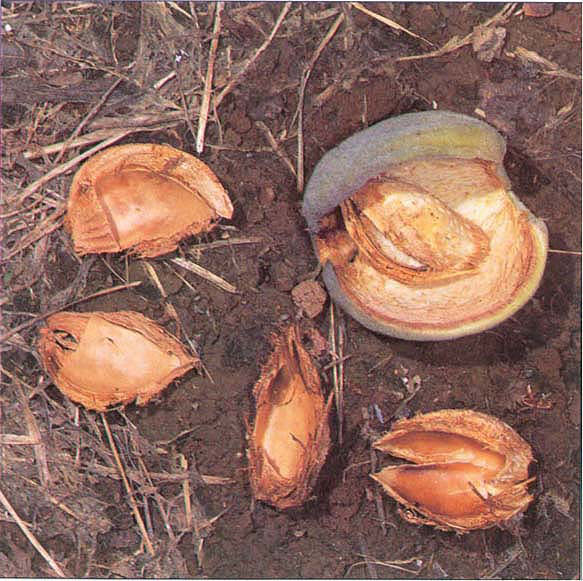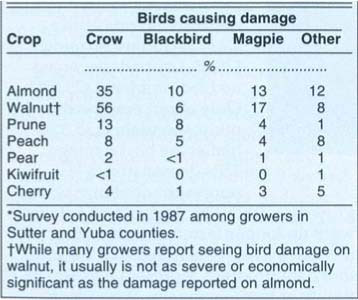All Issues
Crow damage to almonds increasing; no foolproof solution in sight
Publication Information
California Agriculture 47(5):21-22.
Published September 01, 1993
PDF | Citation | Permissions
Abstract
Of all birds causing damage to almonds in Sutter and Yuba counties, crows cause the most, according to a survey of growers. Growers also reported they are willing to spend an average of $24 an acre to reduce damage by 50% within their orchards — far less than the potential value of nuts lost.
Full text
Among California crops damaged by birds, nut crops such as almonds, pistachios and walnuts are particularly hard hit. Although information on natural losses is limited, bird losses to California pistachio crops reportedly exceed $1.8 million per year. The most damage occurs when birds feed on nuts or knock them to the ground when they land in trees.
Within Northern California's Sutter and Yuba counties, almonds are grown on approximately 6,305 acres. For several years, growers have been reporting that birds, particularly crows, are causing extensive crop losses. Because data were not available to document this issue, we surveyed growers in October 1987 for their opinions about bird damage and, to a limited extent, on the effectiveness of their control measures.
Methods
The survey we developed was mailed to 622 commercial tree crop growers in Sutter and Yuba counties, including most of the area's commercial almond growers. The survey asked growers to identify the bird species involved, the extent and degree of damage, the control methods used and the perceived effectiveness of those methods.
The first portion of the survey, identifying the birds causing problems, looked also at the tree crops involved. Although the survey concentrated on almonds, information on other crops was solicited to give us a better understanding of the bird population and potential problems in both counties.
One week after the deadline for returning the survey, reminder cards were sent to those growers who had not returned the survey. Three months later, we randomly contacted by telephone 49 growers on the original mailing list to check for any nonrespondent bias. All telephone contacts who did not return the survey were asked to fill it out, with us assisting them over the phone.
To follow up on the initial survey, 11 growers who had consistently reported bird damage in previous years were interviewed in July 1988 to determine whether they had seen any increases or decreases in crow populations in their orchards. In many of these orchards, damage to nuts had also been reported to, and subsequently observed by, the local UC farm advisor (senior author).
Results
Of the 622 surveys mailed, 145 were completed, a return rate of 23.3%. This return rate is similar to that of other surveys we have conducted on wildlife damage to crops. During the nonrespondent check, 18 contacts (36.7%) indicated they had already returned the survey. Twenty nonrespondents either were no longer farming (38.7%) or had perceived no bird problems (25.8%). Only about one-third of the nonrespondents (35.5%) had some bird damage. This demonstrates a nonrespondent bias where growers without bird problems (or who were no longer farming) failed to return the survey. We concluded that the crop loss data reported represent a liberal estimate of bird damage in almonds in Sutter and Yuba counties, although the degree of damage to the entire local industry cannot be determined.
Scope of the problem
Table 1 lists the tree crops for which growers reported damage by birds and the bird species identified. Except for almonds, we do not have information on the number of responding growers who grew each of the specific tree crops listed. Other crops damaged by birds were pecans, wild rice, melons, grapes, vine seed crops, sugar beets, pastures and apples. Growers reported the American crow (Corvus brachyrhynchos) as the most frequent pest bird of almonds, as well as other crops, followed by the yellow-billed magpie (Pica nuttalli). The Brewer's blackbird (Euphagus cyanocephalus) and scrub jay (Aphelocoma coerulescens) were also reported as commonly causing problems in almond orchards.
To refine the scope of problems crows cause in almonds, we concentrated on their behavior and occurrence in almond orchards. Of the surveys returned, 64 were from commercial almond growers. Of these, 97% reported crows in their orchard. Crows occur in almond orchards throughout the year, with concentrations during the time when nuts are maturing and during pre- and postharvest. Even during winter when trees are dormant, 10% of the growers found crows in their orchards. These crows eat mummy nuts, thereby reducing navel orangeworm, a serious pest of almonds. Flock sizes in the orchard vary; however, most growers indicated that groups of six or more birds were found in the orchard. In most cases, birds in groups of 26 and more were common.
Decisions about investing in bird-control equipment or programs require information about the potential damage these birds can cause. Growers were asked specifically about crop losses from crows feeding in their orchards. Most growers (90%) reported bird damage in their almond orchards. Of growers reporting damage, 98% felt damage is increasing. No grower found crow damage declining. Asked why crow damage was up, most growers (59%) said that crow numbers were increasing and so damage was increasing; changes in the surrounding habitat (unspecified) also seemed to be causing the increase in crows, they said.
Of the 11 almond growers interviewed the following summer, all but one reported crop damage by crows. Four said they had more damage than in previous years, four thought damage was about the same and two felt there had been less bird damage.
Knowledge about the feeding behavior of crows in the orchard is necessary to evaluate their damage and to apply control programs to specific areas where crows are pests. Growers reported both concentrated and dispersed crow damage throughout their orchards at about equal rates. It appears that because damage can be, and often is, distributed throughout an entire orchard, damage prevention has to be orchardwide.
Evaluating damage by crows and other birds in almond orchards is difficult. Most growers simply estimate the entire loss for the orchard. For growers experienced with bird damage and production within their orchards, such estimates can help address the cost/benefits of various control programs. However, because bird damage tends to be sporadic, many growers new to almond production or to bird problems may find it hard to estimate overall losses.
To fully calculate the estimated loss in an orchard, we asked growers to describe the yield loss from one tree with average crow damage. Growers estimated that the yield of an average tree damaged by crows was reduced 20 to 25%. They also indicated that about 15% of the trees in their orchards were damaged by crows. From these estimates, we calculated a 3 to 4% loss in production, about 40 pounds per acre, for those returning the survey. In estimating overall loss, average losses in the range of 1 to 5% and 6 to 10% were reported by 28% and 26% of the growers, respectively; 24% of the growers indicated losses in the range of 11 to 50%.
Control methods used
Growers were asked to rate the methods used to control bird pests. Of all of the measures used to frighten or disperse birds, shooting was the most common, followed by gas cannons (propane exploder), hawk kites (kites that look like predatory birds) and electronic noise makers (AV-Alarm). Shooting and gas cannons were rated by 47% and 40% of the growers, respectively, as giving slight control; 25% and 32%, respectively, said shooting and gas cannons moderately controlled crows. Trapping, netting, recorded bird calls and bird bombs were also used. Asked how much they would be willing to spend to reduce crow damage in their orchards by 50%, growers gave responses ranging from $0 to $100 per acre, with an average of $24.46 per acre.
Asked to list environmental conditions near their orchards that they felt contributed to crow problems, growers commonly listed tall trees and water sources as contributing to specific bird problems. In addition, wooded areas, brushlands and power lines were associated with crow problems.
Conclusion
Among birds, crows reportedly cause the most damage to almonds and other crops throughout Sutter and Yuba counties. Magpies are the second most detrimental bird species reported, closely followed by blackbirds, starlings and scrub jays. Bird damage is believed to be getting worse each year in some orchards, as a result of increased bird numbers.
Control methods vary, depending on their cost effectiveness. To reduce damage by 50% in their orchards, almond growers are willing to spend an average of $24.46 per acre, far less than the potential value of nuts lost to such damage. The most effective deterrent appears to be shooting, followed by gas cannons (propane exploders). No control apparently gives excellent results consistently and no improved alternative has been found.







